Annual Report 2008 - Minhaj Welfare Foundation (MWF)

Index
- Foreword
- Aims and Objectives
- Basic goals
- Slogan
Education
- Establishment of educational intuitions
- Student Welfare Board
Health
- Free dispensaries
- Free ambulance service
- Minhaj blood banks
- Free eye surgery camps
Public welfare
- Shelter Home
- Bait-ul-maal
- Collective marriages
- Women Development Project
- Eid gift and ration scheme
- Water installation project
- Rehabilitation of victims of natural tragedies
- Help for victims of Tsunami-affected people (Indonesia)
- Help for the quake-hit people (Kashmir)
Mode of resource generation
- Collective sacrifices
- Zakat collection campaign
- Donations
Foreword
Humanity is faced with complex problems in the modern age. The fact that man is being grinded by gigantic problems like dearness, poverty, ignorance and lack of basic facilities etc is not hidden from any one. In the developing world, out of 4.4 billion people, 2.5 billion are deprived of the basic health facilities. One third of world population does not have clean drinking water. Only in Africa a population ranging from 75 million to 250 million can face the possibility of water draught till 2020. If measured from the standard of Human Development Index in terms of health, education and income, the sad fact crops up that Pakistan ranks at 138th position. 60 million population of Pakistan out of total 160 million is deprived of clean drinking water. More than 100 million people are illiterate. Thousands of children die due to lack of proper medical facilities. Hundreds of thousands do not have proper food to feed themselves two times a day. Poverty is a great stumbling block and stunts the educational careers of countless promising Pakistani students. Girls of marriageable age cannot get married due to lack of financial resources and dowry etc. There is no public arrangement for looking after widowed, helpless and the poor in society. There is a need to make practical efforts for the welfare of the suffering humanity in these deplorable conditions.
Aims and Objects
Shaykh-ul-Islam Dr Muhammad Tahir-ul-Qadri laid the foundation stone of Minhaj Welfare Foundation (MWF) to render services in the field of public welfare. The objective behind establishment of this Foundation is to arouse feelings of sympathy in human beings, to create atmosphere of mutual love, brotherhood and to work for the establishment of a real Islamic welfare society by including the less privileged sections in the mainstream. The need of such effort is all the more acute in view of the fact that the developing world lacks proper organized arrangements at the official level contrary to the developed world. The Minhaj Welfare Foundation is engaged in the service of humanity by rising above the distinctions of caste, creed, sex, colour and religion.
Basic goals
- Spread of purposeful, quality and cheap education
- Provision of scholarships for poor and deserving students
- Provision of quality and cheap medicine for those without proper health facilities
- Women-targeted welfare plans
- Plans for rights and welfare of children
- Making the orphan and helpless children useful members of society by providing them with education, residence and training
- Support and rehabilitation of those affected by natural tragedies
- Provision of clean drinking water in backward areas
- Financial support of the poor and deserving people through Bait-ul-Maal
- Establishment of dowry fund for marriages of poor and deserving girls
Our slogan
Our resolve, our work
Education, Health and public welfare
Education
Educational Project
The progress and rise of any country depends largely upon the educational strength of its people. The basic purpose of education is the formation of a balanced personality and the basic objective of educational system is the establishment of a balanced society. If looked at an individual and society from this point of view, neither do we see balanced personality nor balanced society. The basic reason underlying this phenomenon is ignorance. Today the whole of Muslim Umma and Pakistani nation are faced with the formidable challenge of ignorance. Unfortunately our country stands at 178th position from the perspective of literacy. The primary literacy ratio of many countries of Asia is better than ours. For example Japan, Sri Lanka and South Korea have 100% ratio, while Indonesia 90%, Thai Land 96%, Iran 95%, India 78% and Bangladesh 62%. In comparison to these countries, the official figure of literacy rate in Pakistan is 39% and unofficial is 26%. According to the international definition of UNESCO, our literacy rate stands at 17%. Pakistan also lags behind many African countries in literacy ratios. History stands witness to the fact that no nation progressed in any walk of life until it achieved minimal 40% benchmark of literacy. Industrial revolution took root in UK only when it obtained the 40% ratio of literacy. In the middle of 19th century, the literacy rate in France was higher than in UK. This was the time in the French history when the country progressed by leaps and bounds. 21% increase in the national assets of US owes itself to education. 25% increase is also being registered in the national wealth of Japan due to education.
The above-mentioned facts highlight the point that Pakistan will have to increase its budgetary allocations for education in order to progress economically and socially. The idea of social progress cannot be rendered into practicality without the advancement in the field of education. This is an accepted reality that the reason behind the Muslim reign of twelve hundred years over the world was its self-sufficiency in the field of knowledge and education. After the political decline, the Western imperialism specifically targeted the educational system of the Muslims. Our educational system was bifurcated into two branches: religious seminaries and modern educational institutes. The remainder of job was done by Lord Moakley when imperialistic system of education was introduced aimed at creating slave nation rather than polishing the creative abilities through these modern institutes.
After winning freedom from the forces of imperialism, efforts aimed at bringing about Islamic renaissance were launched with many distinguished personalities rendering their services in the field of education. The department of education ranks at the top among the areas where Shaykh-ul-Islam Dr Muhammad Tahir-ul-Qadri is leading the nation through his matchless efforts and struggle.
According to Dr Muhammad Tahir-ul-Qadri, the reason behind all social ills of our nation (unemployment, addiction, extremism, terrorism, domestic quarrels and strife, robberies, theft and violation of human rights) is ignorance. The solution to these problems can only be found through spread of education. That is why Dr Muhammad Tahir-ul-Qadri has declared that "Sir Sayed Ahmad Khan gave nation one Ali Gardh, I will give it one hundred." That is why Minhaj Welfare Foundation has embarked upon a project of education to create awareness among people and bless people with the light of knowledge by steering them out of darkness of ignorance. Scholarships should be arranged for poor but deserving students and free books should be made available for the needy students.
Establishment of educational institutions
A network of educational institutions has been laid across the country under Minhaj Welfare Foundation (MWF). In almost a period of nine years, 572 schools and 41 colleges have been set up throughout the country. The abridged details are given below:
| Level
|
No. of Schools
|
Establishment per School
|
Total Expenditures
|
Expenses on Expansion
|
Fee Concession
|
Total Expenditures
|
| Minhaj Public Schools
|
319
|
75,000
|
2,39,25,000
|
3,95,56,30
|
1,60,00,000
|
8,94,81,000
|
| Minhaj Model Schools
|
253
|
1,50,000
|
3,79,50,000
|
5,06,00,000
|
2,13,00,000
|
10,98,50,000
|
| Minhaj IT colleges
|
17
|
3,00,000
|
1,23,00,000
|
2,05,00,000
|
86,00,000
|
4,14,80,000
|
| Total
|
589
|
|
7,41,75,000
|
11,06,56,000
|
5,59,00,000
|
24,07,31,000
|
Characteristics
- Minhaj Welfare Foundation and its affiliated organizations provide all resources for the establishment of such educational institutions.
- Minhaj Welfare Foundation bears the educational expenditures of at least 25% poor but deserving students in these institutions.
- The schools books are given free of cost to the poor and needy students.
- The annual examinations and the results of all classes are conducted under the supervision of Minhaj Education Board in order to maintain educational standard.
- These educational institutions are not meant for education for the sake of education and for issuance of degrees only. Their prime objective is to make a student a good Muslim and a useful citizen with a positive mind.
- Special attention is paid on the moral and spiritual training of the students in these institutions.
Student Welfare Board
Education never ranked high in the priorities of policy makers in Pakistan and elite class never took interest in this matter, which is proven by the low budgetary allocations in our national budget statement each year. In 1972 the federal government formulated first national educational policy and under which primary education was declared free but bureaucracy hindered the move. Following the permission of private institutions, education became costly. In 1991 efforts were made to bring about changes in the field of education and money of 'Iqra surcharge' reached 10 million rupees. The money should have been spent on the improvement of educational department but the policy makers used this money for other purposes.
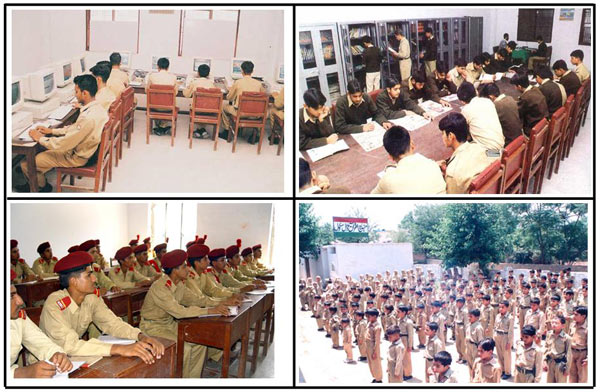
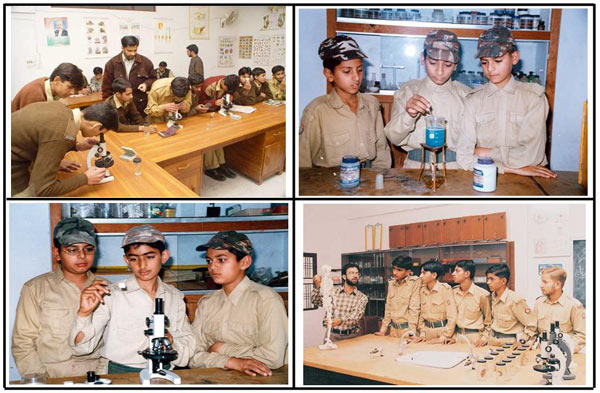
Minhaj Welfare Foundation arranges scholarships for those poor and needy students who are otherwise very intelligent and competent but due to lack of resources cannot get education. Under Minhaj Welfare Foundation, Student Welfare Board was established for this purpose. Scholarships are given to poor and needy students for secondary and higher education through it. The details of students who pursued their studies by benefiting from the scholarships provided by this board so far are given here below:
- Hafiz-e-Quran 726
- Matriculation 510
- B.A. 552
- Masters 199
- Professional courses 08
- P.hD 02
| Educational Level | Details | Monthly Expenditures | Annual Expenditures | Total Expenditure of Course | Remarks |
| Hifz-e-Quran | After Primary (3+1 Years) | Rs. 2,000 | Rs. 24,000 | Rs. 96,000 | Students also get education up to middle level along with Hifz |
| Secondary School | 6th to 10th (5 Years) | Rs. 2,000 | Rs. 24,000 | Rs. 1,20,000 | Formal Education of Educational Board is imparted. |
| Degree College | Intermediate to Graduation (4 Years) | Rs. 2,500 | Rs. 30,000 | Rs, 1,20,000 | Matriculate students are given education from Intermediate to Graduation |
| MA (Ash-Shahadat-ul-Aalamiyya) | Intermediate to Post Graduation (7 Years) | Rs. 3,000 | Rs. 36,000 | Rs. 2,25,000 | Approved by HEC |
| I.Com | Two-Year Course | Rs. 3,000 | Rs. 36,000 | Rs. 72,000 | Two-Year course after matriculation |
| F.Sc | Two-Year Course | Rs. 3,000 | Rs. 36,000 | Rs. 72,000 | Two-Year course after matriculation |
| B.Com | Two-Year Course | Rs. 5,000 | Rs. 60,000 | Rs. 1,20,000 | Two-Year course after I.Com |
Total 1997
The project has cost more than 22,44,96,120 rupees in total benefiting 1997 students. 187 students are enjoying the facility of concession in fees at this point in time. The scholarships given by Minhaj Education Society are not included in the above-mentioned category nor are the concessions granted in colleges part of this, which amounts to millions of rupees.
Methodology
Under this project, the students are required to put up an application on a prescribed form. Merit is chalked out on the criteria of educational performance of students, their economic condition and participation in extra-curricular activities. Only those students fulfilling the demands of merit are awarded scholarships. Every student is given under the care of a donor who bears all of his educational expenditures. The donor is kept informed of the educational performance of the child. Scholarships are awarded annually and only those students are able to get scholarships for the coming year who come up to the criterion and show consistent performance. The following packages of student scholarships have been made for the facilitation of the donors. Any one wishing to finance the education of a student can send donation to the Minhaj Welfare Foundation. Such donor will be kept informed of the credentials and performance of the student as per rule.
Student Sponsor Package
Note: The above-mentioned courses are conducted at the central educational institutions of Minhaj-ul-Quran located at Township Lahore. Separate institutes for male and female students are available where moral and spiritual training is imparted to students. In addition to that, the deserving students of Engineering Universities and Medical Colleges are dealt with on case to case basis and are supported as per rule.
Health
Minhaj Free Dispensaries
Pakistan is a developing country and 1/3rd of its population is living below the poverty line. The acquisition of basic facilities of health is the right of every citizen and responsibility of state. More than half of population is deprived of generic facilities of health. The dangers posed to health have increased manifold with the passage of time. The state of health in Pakistan has deteriorated miserably in recent years. Pakistan still faces the problem of less number of doctors, nurses and other necessary items in comparison to the demands of total population. The prices of medicines have shot up and it has become impossible for the common man to afford medication these days. The price of cloistral-reducing drugs in India is Rs. 8, while it is Rs. 60 in Pakistan. Likewise the prices of blood pressure-reducing drugs in India and Pakistan stand at Rs. 10 and Rs.100 respectively. There is a great difference in the prices of the drugs composed of the same ingredients of the various companies. The government has promised many a time to set up "Drug Regulatory Authority" but this promise has not been materialized. Keeping all these conditions in view, Minhaj Welfare Foundation started project of free dispensaries with an aim to provide better health facilities to the public. The patients are given free medicines by the Minhaj Welfare Foundation in these dispensaries along with medical check-up.
The total number of Minhaj Free clinics and blood banks throughout the country is 110. The establishment of this network has cost Rs. 40 million and thousands of people are benefit from this. Embulance service expenditure 1,50,20,400.
Minhaj Blood Banks, Thelesemia and Hemophilia Centers
Thelesemia is very fatal disease. The red blood cells are not developed originally in majority of the patients suffering from this disease. The lungs of the patients start getting enlarged. Every patient of Thelesemia needs one bottle of blood in a period of 2 to 3 weeks and in case of non-availability, it could be pretty dangerous.
The patients suffering from hemophilia get free medical facility and FFP from blood in Minhaj Blood Banks. If blood starts oozing out of any part of body, it hardly stops. Such patients need 2 to 5 bottles of FFP blood in a period of 2 to 3 weeks and in case of non-availability, life could be lost.
Dialysis is that process of washing of kidneys in which the kidneys are to be washed once between 3 and 7 days. This disease causes lessening of blood in human body and at every time of dialysis, blood with the ingredients like FFP/platlets is needed. Without the availability of blood, dialysis is not possible and without dialysis life of patient is in danger.
Minhaj Blood Bank makes the availability of blood with necessary ingredients possible for the patients of cancer because the immunity level of the patient of cancer is weakened. The blood and its ingredients start getting reduced in body. So in order to remain alive, a patient needs blood with necessary ingredients. No such patients can be cured without availability of blood and blood with necessary ingredients.
Minhaj Blood Bank, Thelesemia and Hemophilia Center is working appreciably well in Multan. Minhaj Free Blood Banks are offering their services in the vicinities of all big hospitals of country. Thousands of people have got benefited from this project so far. Our aim is not only the provision of blood but of quality blood.
Free Eye Surgery Camps
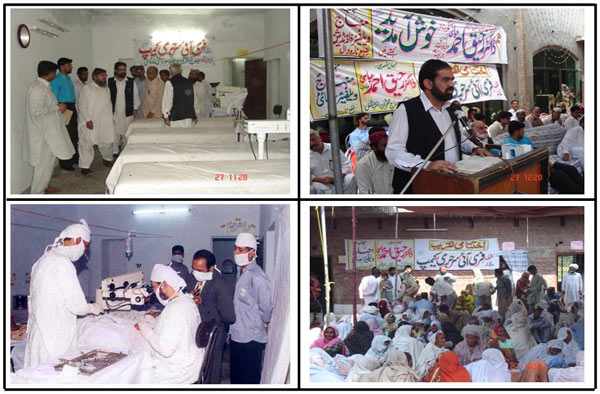
Eyes are the most valuable gift of Allah Almighty and are an important and beautiful organ of our body. They make us observe surroundings around us. In Pakistan where general state of health is getting deteriorated by the day, the diseases of eyes are also increasing there. Environmental pollution is the chief reason of this malaise. There are around 6 million blind people in the world today. The number of blind people in Pakistan is also increasing. Keeping this situation in view, Minhaj Welfare Foundation (MWF) started holding free eye surgery camps in the backward and far-flung areas of Pakistan. According to the prevalent concept of eye-camp in Pakistan, it is getting oneself checked up by a doctor one day and getting a prescription of medicine. Whereas annual free surgery eye camp is held under the banner of Minhaj Welfare Foundation benefiting hundreds of patients each year. Some of the prominent characteristics of these camps are given below:
Characteristics of these camps
- The camps are held under the supervision of experienced doctors of big hospitals of Lahore.
- Medicines and equipment of international standard is used in these camps.
- These camps are held in those districts which National Commission for Human Development has identified as being backward. Minhaj Welfare Foundation focuses on these far-flung backward areas for OPD camps where people find it hard to come to cities for treatment owing to poverty and ignorance. Thus they get the medical facility at their doorstep through MWF.
- Our teams of doctors visit such rural areas and hold OPD camps prior to arranging surgery camps where the deserving people get fist aid medicine on the spot whereas more serious patients are given dates of operation. It is in this way that 3000 people are operated upon annually.
- The patients recommended for operation by the OPD initial camps are operated upon within three days under the supervision of expert professors.
- The patients are kept under the medical treatment for a day or two. Minhaj Welfare Foundation is responsible for boarding and lodging of such poor patients.
- Minhaj Welfare Foundation also arranges for the provision of lenses as per patients' needs and post-operation eye drops etc.
- About 500 patients are operated upon annually.
- The patients belonging to middle, lower middle and lower class benefit from such camps.
- Our doctors do not leave patients helpless after operations. They are checked up medically after every 15 days for three months and administered medicine on per need basis.
- The district governments have declared these camps as highly organized and welfare-oriented. The government organizations have expressed their gratitude for the Minhaj Welfare Foundation for undertaking this noble cause.
- A complete progress report so far:
Number of free camps since 1998 ................ 11
Number of patients checked up ................ 30, 283
Total number of operations ................ 2319
Operation + number of general eye check-up ................ 32,602
Total expenditure so far ................ Rs. 60,30,955
Average expenditure per patient ................ 3000 (15,000/- expenditures of lens)
Practical support of the deserving patients
Such patients who do not get proper care in the hospitals and face difficulties in the procurement of medicine etc, the Minhaj Welfare Foundation gets their problems resolved by arranging meetings with relevant authorities. If need be, monetary support is also provided to such patients for ensuring good treatment. So far 732 patients have been given economic support.
Public Welfare
'Aagoash': Orphan Care Home

The upbringing, education and training of those poor and deserving students whose parents have died, is the responsibility of society. If a child remains unattended, he causes disturbance in society and society has to pay for it. Islamic teachings have enjoined upon Muslims to show mercy and affection for the orphans. In the light of these teachings, a comprehensive plan has been worked out for the education, upbringing and sustenance of orphan and helpless children. "Aagoash" will be an institution for 500 orphan children. The first phase has been started accommodating 50 students.
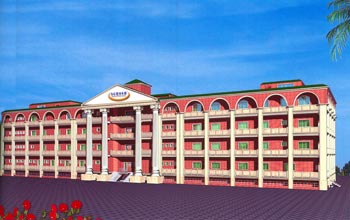 Some characteristics
Some characteristics
- Only the orphan children are admitted in 'Aagoash'.
- Education & training of children has been properly arranged.
- Free boarding has been provided to the children.
- Children are provided with quality food stuff like milk, fruit etc.
- A caretaker woman has also been appointed for supervision of children.
- A Qari has also been provided for imparting Quranic education.
- Teachers have been deputed for teaching children at evening time.
- A home-like atmosphere has been provided so that they do not develop inferiority complex.
- The institute will have the responsibility of education, training, business and marrying off the child when he grows up into a youth.
- One child is assigned under the care of a donor and he is periodically kept informed of his performance.
Bait-ul-Maal
The poverty line starts at Rs. 457 per head monthly and the average income of 40% of Pakistan's population is less than that. About 60 million people are deeply mired in the web of poverty. The result of unjust distribution of resources is that a small minority has usurped the resources. To top it all, dearness has pushed the common man even further in the blind alley of poverty, destitution and helplessness.
The number of people under ones economic dependence is increasing because of rising rate of unemployment. Today 100 people are economically dependent on 65 people, while in view of increasing economic difficulties by 2018, 100 people will be economically dependent on 40 people. According to 1998 census, the ratio of unemployment in Pakistan was 19.7% including male unemployment rate at being 20.2% and female rate at 5.1%. In the same way, Pakistan's situation is not better in the field of health. The cost of treatment has risen so tremendously that it has become next to impossible for common man to get medical treatment within affordable cost. There is no denying the fact that the daily income of 74% population is less than 2 dollar a day, while the wages of a worker stand at 4000 a month at the official level. In the last five years, the economic burden has increased on the poor and middle classes.
The price hike noted in last five years in commodities like rice, ghee, sugar, flour, meat and mutton is 200%, 110%, 50%, 40%, 150% and 100% respectively. There are innumerable families where children cannot even see fruit leave alone eating it. Keeping this situation in view, Minhaj Welfare Foundation started the Bait-ul-Maal Fund on monthly basis for extending help to the poor and less privileged sections of society. Bait-ul-Maal is of huge importance in Islamic society. It is an institution for the rehabilitation of the poor and helpless people. Minhaj Welfare Foundation launched its project of Bait-ul-Maal in the light of Islamic teachings so that the deserving people should be helped out. Such people are given financial help who may be able to get out of economic worry with one dose of help for example:
- Help for establishment of small business
- Provision of medicine for treatment
- Financial help for the marriages of girls
- Provision of ration etc
- Provision of unemployment
Methodology
A written application is required on a prescribed application format. The person has to provide the photo-copies of the relevant documents with the application. Our representative verifies it himself and aid is finally approved by the welfare board. Following expenditures have been incurred on the following areas since inception:
- Medical treatment Rs. 41, 61, 500
- Dowry Fund Rs. 36, 38, 852
- Financial help Rs. 39, 78, 367
- Total Rs. 1, 17, 78, 719
Collective Marriages
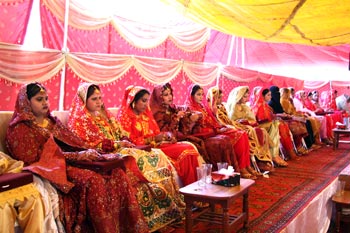
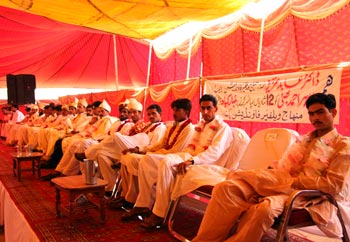
There is no doubt about the fact that man and woman both are the lynchpin for the smooth functioning of domestic life in its ebbs and flows. The continuity and longevity of conjugal life is the foundation upon which edifice of society and collective life is erected. Both man and woman are the important characters of this arrangement. But it is misfortune of our society that woman—the most important component of society—has invariably been looked down upon. Before inception of Islam, woman was considered as sex symbol in almost every part of the world. But with the inception of Islam as peaceful religion, the reformation of society was started with declaration of respect for womenfolk. So when Islam talked of respect for woman, it provided a complete set of values for her external and internal protection. For the continuity of human race and establishment of moral and ethical standard for dignity of woman, it enjoined contracting of marriage.
It is a hard fact that marriage of a daughter has become quite a burden on the parents. The family of groom looks for big dowry, while with the birth of girl-child, her parents start worrying for her dowry. It takes struggle of years for the parents and brothers of family to marry off one daughter. The lives of parents are consumed in the efforts for earning in order to arrange big dowry for their daughters but even then they fall short of fulfilling the demand. In a few cases, parents take the extreme step of committing suicide or the girl, while considering herself to be burden on the family, does the same.
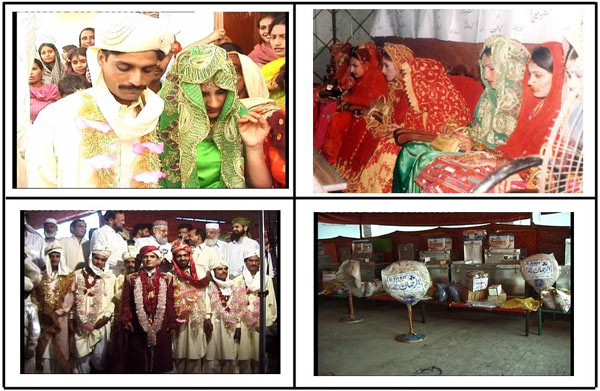
Diagnosing this social ill, Shaykh-ul-Islam Dr Muhammad Tahir-ul-Qadri took practical step for the practical cure of this disease. He brought back the smiles on the faces of poor parents by helping them to arrange marriages of their daughters under the auspicious of Minhaj Welfare Foundation.
Arrangement of collective marriages by the Minhaj Welfare Foundation has become a feather in its cap for last few years. Collective marriages are also arranged not only in Lahore but also in other cities of the country. The branches of Minhaj Welfare Foundation undertook this project with great zeal and determination. The basic details and information of these collective marriages are given here below:
- Bride is given complete dowry of domestic use.
- 50/50 guests of both bride and groom are entertained at the marriage.
- A good seating arrangement of guests is also done.
- Care is taken to make sure that at no point in time should the bride and groom feel inferiority complex.
- A bridal gift consisting of the following is also gifted to the newly-wed couple:
- Prayer Mat
- Holy Quran
- Sewing Machine
- TV set+ Cutlery set
- Dinner set
- Double bed plus bed sheet
- Covering cloaks
- Suit case/Brief case
- Suits for bride and groom
- Colour television
- DVD Player
- Gold set
- Washing machine
- Pedestal fan
- Food for 50 people
The marriages of 325 girls have been arranged by Minhaj Welfare Foundation. It costs Rs. 1.25 lac at one marriage and so the total expenditure incurred is Rs. 3, 37,85,000. The cooperation of local wealthy individuals is a sign of trust in Minhaj Welfare Foundation.
Woman Development Project

55% population in Pakistan consists of women who have an important role to play in the national economy. It is our foremost obligation to equip them with any type of skill in order to give them honourable place in society and home. Technical educational intuitions and computer centers have been established in this respect where arrangements have been made for the technical education of women. In addition to that, the plans for the widows include the free provision sewing machines so that these women may be able to earn respectable living at home. 200 machines have been provided so far which has cost Rs. 5, 95,500.
Eid Gift and Ration Scheme
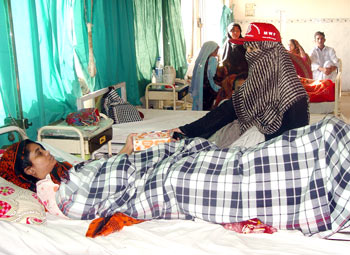
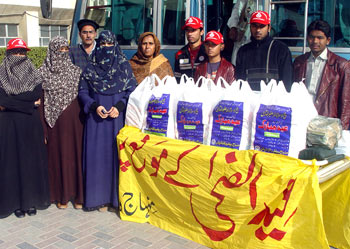
Food is the most important component for human survival. But the problem is: will sufficient food be available to meet the demand of growing population? It is now obvious that there is a need of increase in the production of food grain to cater to demands of over 160-million population. The situation is that we do not have food free from diseases. There is a need of increase in per head production of food grain. The ratio of diseases is more due to shortage of food in Pakistan. 10% Pakistani children are getting affected due to defective food. The demand of food grain is on the rise in the developing countries. There is a dire need to ensure availability of balanced food for people.
It is a reality that those most affected by the shortage of food belong to the poor and lower classes. Poor people die due to starvation and are deprived of even small pleasures of life. Leave alone the normal circumstances; the children of the poor can not get new clothes at the occasion of Eid. In this situation, Eid gift and Ration Scheme was started under the banner of Minhaj Welfare Foundation to distribute happiness among the poor. Under this scheme, ration, sweet and food stuff are distributed among the poor at the time of Eid.
Water Pump Installation
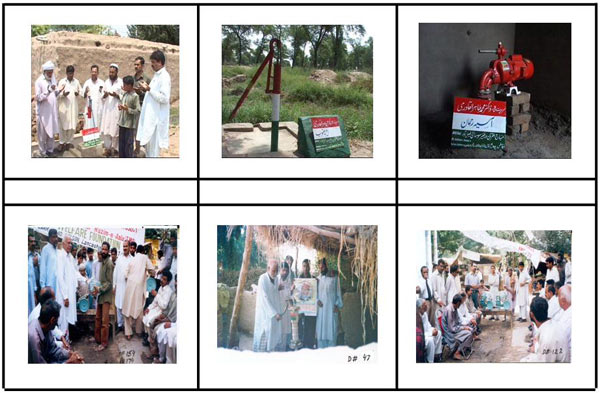
Water is one of the most valuable blessings bestowed upon us by Allah Almighty. Water is central to the growth of life and no life can be imagined without it. It is valuable gift of Nature and is one of the fundamental contributory factors to the existence of life on the face of earth. 3/4 portion of our earth is composed of water and every country acknowledges its importance. According to experts, 4 gallons of water are required for every human being. According to international standard, there is a need of 50 cubic meters per person annually or 30 gallon of water per person. The provision of this much water is possible in urban areas but in the rural areas, getting even one gallon of clean water person is next to impossible. Women have to travel long distances for water in desert and rocky areas. Due to invading human beings and animals over fountains, the water becomes polluted and causes many diseases. This includes diseases related with abdomen, kidneys and skin etc. One characteristic of water is its being solvable as a result of which it becomes polluted in no time. The news regarding adulteration of a poison called 'sankhia' with underwater in the interior of Punjab of Sind are also disturbing. The quantity of 10 microgram 'sankhia' in one liter water causes cancer. The diseases born out of water and cleanliness are the basis of 60% deaths of children in Pakistan. According to an estimate, 80% of our diseases originate from the use of defective water.
In South-West countries, the phenomenon of cancer is caused by ruination of rocks and melting of mineral components. But this ratio of poisonous pollution is on the rise because of absorption of industrial waste by the soil. The adulteration of industrial waste and pesticides etc with water has rendered it unusable. Keeping in view the havoc caused by the 'Katrina' in US and 'Tsunami' in Asia, the importance and utility of clean water has increased manifold warranting timely and quick response.
- Lahore
- Sheikhpura
- Rawalpinid
- Islamabad
- Palandari (Azad Kashmir)
- Mir Pur (Azad Kashmir)
- Tardkhul (Azad Kashmir)
- Jangh
- Layyah
- Dera Gazi Khan
- Bahawalpur
- Muzzafar Gardh
- Multan
- Sargodha
- Gunjrawala
- Jehulm
- Gujtat
- Faisalabad
- Rajun Pur
- Mansarah (NWFP)
- Kohat (NWFP)
- Mianwali
- Jafarabad (Blauchistan)
- Naseerabad (Blauchistan)
If one the one hand, the climatic changes caused shortage of water, it also caused migration of human beings on the other leaving the human settlements deserted. On the basis of scientific progress, the use of mineral resources from the innermost recesses of soil has become possible through various tools in the modern age. But at the same time, the reality has also dawned upon us the fact that reservoirs of water underneath soil are very limited and are intact by a system of balance. Last eight years have seen an increase in the urban population of Pakistan by 10% to 12%. The ratio of increase in water in the urban areas is more than that. According to international standard, the urban areas need 50 cubic meters of water per head annually or 30 gallon per head on daily basis.
More than half of Pakistani population is deprived of clean drinking water today. Unclean water is available for drinking at most of the places giving birth to fatal diseases. Given this growing need of clean drinking water, Minhaj Welfare Foundation has started project for availability of clean water. Under this project, a plan of installing 1500 water pumps is underway across the country. Out of that number, 750 water pumps have been installed costing Rs. 3.468 million. The water pump installation campaign has covered following districts:
Rehabilitation of victims of natural disasters
Whenever any natural calamity strikes inside or outside of Pakistan, Minhaj Welfare Foundation is at the forefront in the efforts at rehabilitation of those affected by it. Its performance is given here below:
- Help of Afghan and Kashmiri migrants Rs. 47,00318
- Flood victims (Sind) Rs. 20, 10,000
- Victims of starvation (Baluchistan) Rs. 25, 10, 000
- Victims of rain (Gilgit) Rs. 2,00,000
- Victims of flood (Rawalpindi) Rs. 9,00.000
- Victims of earthquake (Bam) Rs. 55,00,000
- Tsunami victims (Indonesia) Rs. 1, 00,00,000
- Victims of (Muree, Abotabad, Mansareha) Rs. 10,00,000
- Victims of rain (Naseerabad, Pasani) Rs. 5, 00 ,000
Note: this data has been collected from the local organizations and money spent so far on these various activities falls in the neighborhood of Rs. 2, 73, 20, 318.
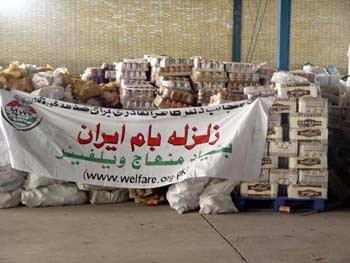

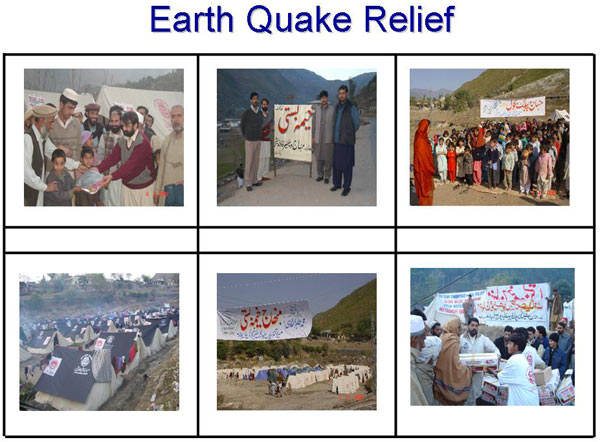
Rehabilitation of earthquake-hit victims of Kashmir
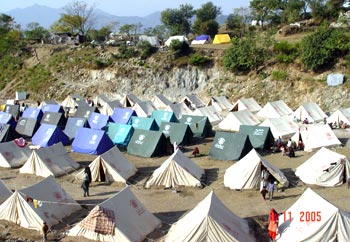 On the morning of October 8, 2005, Kashmir, Northern Areas, parts of NWFP (a Pakistani province) and federal capital Islamabad underwent catastrophic earthquake that resulted into a vast destruction both of human life and infrastructure like cities, business centers, educational institutions, hospitals, communication system etc. Beautiful residential houses, lush-green valleys and tall buildings were reduced to heap of debris in no time. Hundreds of thousands of children, women and men became disabled for the whole of their life. Thousands of married women became widows within twinkling of an eye and many old people were left shelter-less and helpless. The number of those who got displaced cannot be counted with fast approaching winter staring them in the face. Many people lost their sense of mental balance at this gigantic destruction. According to eye-witnesses, not only did the buildings stand razed to the ground but many villages also got dumped into the earth. Those who were fortunately saved from this tragedy had many misfortunes to mourn over like destruction of houses and businesses, deaths of relatives, friends and near and dear ones. Many mountains of grief, pain and worries stood like a rock before them. How difficult was to reconstruct a house in this age of dearness? Who would take care of the orphan and the helpless children? Who will look after the crippled and the disabled? Who will provide for the widows? This all-embracing destruction impacted adversely upon the people both economically and socially.
On the morning of October 8, 2005, Kashmir, Northern Areas, parts of NWFP (a Pakistani province) and federal capital Islamabad underwent catastrophic earthquake that resulted into a vast destruction both of human life and infrastructure like cities, business centers, educational institutions, hospitals, communication system etc. Beautiful residential houses, lush-green valleys and tall buildings were reduced to heap of debris in no time. Hundreds of thousands of children, women and men became disabled for the whole of their life. Thousands of married women became widows within twinkling of an eye and many old people were left shelter-less and helpless. The number of those who got displaced cannot be counted with fast approaching winter staring them in the face. Many people lost their sense of mental balance at this gigantic destruction. According to eye-witnesses, not only did the buildings stand razed to the ground but many villages also got dumped into the earth. Those who were fortunately saved from this tragedy had many misfortunes to mourn over like destruction of houses and businesses, deaths of relatives, friends and near and dear ones. Many mountains of grief, pain and worries stood like a rock before them. How difficult was to reconstruct a house in this age of dearness? Who would take care of the orphan and the helpless children? Who will look after the crippled and the disabled? Who will provide for the widows? This all-embracing destruction impacted adversely upon the people both economically and socially.
Minhaj Welfare Foundation (MWF) took timely steps for rescue of those still buried under the debris, provision of necessary items of foods and clothing, rehabilitation of affected people, construction of houses and schools by allocating millions of rupees. These projects are still underway.
After this cataclysmic earthquake, Minhaj Welfare Foundation established 15 tent settlements in areas of Muzzafarabad, Bala Koat, Batgram, Valley of Neelum etc. More or less 1500 people were fed in these settlements for six months where facilities like temporary housing, food, clothing, iron sheets, medicines, free medical service and free ambulance service have been provided. In addition to that, millions of rupees were distributed in the form of cash. More than 2.5 million rupees have been spent so far. 600 Shelter Homes were also established. Besides this, the construction of schools and mosques has been started that is estimated to be around 25,50,00,000 million rupees.
Oceanic storm (Tsunami)
The earthquake and Tsunami that hit 12 countries of the world including Indonesia, Sri Lanka and Thai Land on December 24, 2004 eliminated thousands of villages and cities. Buildings were destroyed and hundreds of thousands of people fell pray to this natural disaster with millions more getting displaced. Tasked with arduous job of rescue, relief, treatment of the injured and their rehabilitation, many NGOs launched fund generation campaigns both individually and collectively at official and unofficial levels. Minhaj Welfare Foundation (MWF) also did not lag behind any other welfare organization in this endeavour.
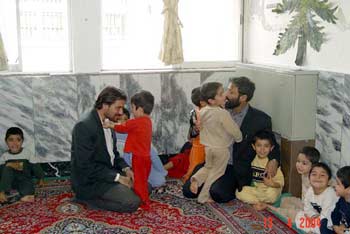 Minhaj Welfare Organization rendered its services for the rehabilitation of the affected people by tsunami in the province of Indonesia called Ache. Under the said Foundation, the services rendered for emergency relief and repair of a Mosque named as "Rahmatullah" as a first part of phase are given here below:
Minhaj Welfare Organization rendered its services for the rehabilitation of the affected people by tsunami in the province of Indonesia called Ache. Under the said Foundation, the services rendered for emergency relief and repair of a Mosque named as "Rahmatullah" as a first part of phase are given here below:
- Reconstruction of houses
- Provision of fishing boats
- Provision of employment to 120 families
- Provision of Water Treatment Plant
- Declaration of scholarships for the orphans of Ache in Minhaj University Lahore (Pakistan)
- 1 lac US dollars were spent on the project
Mode of resource generation
- Sacrificial skins
- Zakat
Sacrificial skins
The Muslim Umma celebrates the day of sacrifice in the pursuit of 'Sunna of Huzrat Abraham" every year. Sacrifice represents that sunna of the Prophet whose observance has been made binding upon the Muslims. One virtue or good is entered in the register of ones functions against every hair of sacrificial animal. There is no limit to its blessings. The meat of sacrifice is halal and the very event of sacrifice has become the means of economy. The sacrificial animals cause growth of markets. If one the one hand, sacrifice is the means to find access to Divinely blessings, it is also instrumental in the availability of meat to the poor and downtrodden on the other. The skins of animals also play important role for the welfare projects of welfare organizations. The Holy Quran not only enjoins upon us to use sacrifice for the purpose of economic activity but Allah Almighty has also ordained such a just method of distribution of meat that it causes happiness to every individual of society. Minhaj Welfare Foundation is busy in spreading this happiness among the poor and less privileged sections of society with your cooperation and active support throughout the world today.
Economic resources are obtained from the collective sacrifices offered at the Markez (Central Secretariat) under the Minhaj Welfare Foundation. MWF offers the sacrifice of about 2400 animals annually at the time of Eid-ul-Azha. People deposit their shares both from inside and outside Pakistan in this collective sacrifice. The animals are bought and sacrificed and meat distributed in accordance with their instructions. Or it is distributed in outskirts of Lahore where the poorest people live. 400 kg meat is distributed among the poor through this campaign. 300 workers of Minhaj Welfare Foundation work hard day and night for 15 days to complete this process successfully, while the skins obtained from this sacrifice are the source of income for Minhaj Welfare Foundation. Allah Almighty be thanked that with His blessings and active participation and encouragement of people, the number of individuals taking part in this collective sacrifice is on the increase with every passing year.
Zakat campaign
Islamic system of Zakat is modern and unique system in the history of mankind. It is a system that was neither conceived by human thought nor did any system ever present such a comprehensive mechanism. No doubt Islamic system of Zakat is characterized with collective, political, religious and moral aspects. It is a matchless economic system. Zakat is an eternal source for the Bait-ul-Maal that is spent for the meeting the needs of the helpless and destitute. And it is an effective check against the immoral concentration of wealth. Zakat is a collective system aimed at creating unity and brotherhood and removing sufferings from the society. The difference between haves and have-nots is bridged and inequalities are removed. The walls of hatred and jealousy are broken down. Thus many high ideals of society are achieved and solution to many problems of society is found. Zakat is also a moral system since it purifies the heart of the rich and saves them from the scourge of miserliness. Zakat is a cooperative society and insurance company of Muslims. It is their provident fund. It is source from which the upbringing of the disabled, crippled, orphan and widows takes place.
Today the situation has come to such a pass that people do not pay their Zakat. If at all they pay, they do not pay fully. Islamic Ideology Council made efforts for it and promulgated Zakat and Usher Ordinance 1980. The hard luck is that whatever reaches government does not reach the poor or the purpose of Zakat is not achieved. According to an assessment of an economist, thousands of people are wealthy in Pakistan. According to a rough estimate, the total Zakat of Pakistani people is around 5 billion US dollar annually. If houses of average standard were to be constructed with Zakat of one year, at least one and half lac houses could be built up for the poor. If the arrangements of upbringing and education of orphan children are to be made with the same amount, 300 such centers can be constructed which would accommodate more than one lac children. If proper system of Zakat is implemented in the country, it would bring about economic revolution in Pakistan. Such grand projects can be initiated that can positively impact upon the lives of the most backward sections of society like labourer, small shopkeepers, daily wage earners etc. Minhaj Welfare Foundation spearheads campaign annually for the collection of Zakat. The economic resources so collected are used for welfare projects aimed at redressal of grievances of the suffering humanity.
An appeal
There are hundreds of thousands of helpless, deserving people including those hit hard by the natural calamities around us beseeching for help. In these circumstances, heavy responsibility rests on the shoulders of common people in general and well-to-do sections of society in particular to join their forces with the organizations working for the betterment of society. Minhaj Welfare Foundation is engaged in the struggle for support and rehabilitation of the less privileged people. Come and support this organization in this pious cause. Let us commit ourselves to returning smiles on the gloomy faces of the poor. Let us spend our money in the way of Allah and prepare for the Hereafter. Come forward and contribute your donations and Zakat etc to Minhaj Welfare Foundation for the service of suffering humanity.

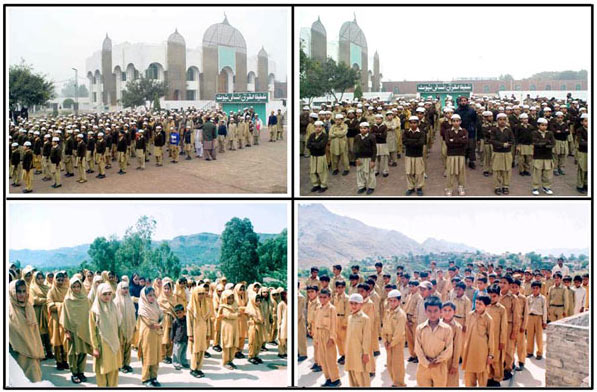





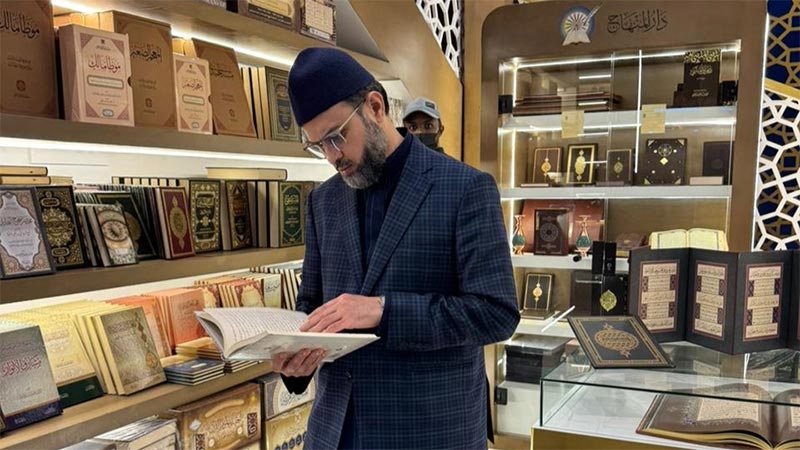
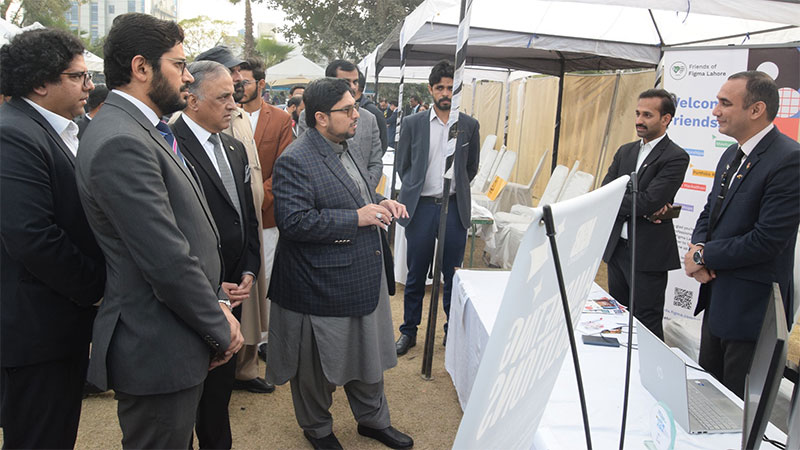
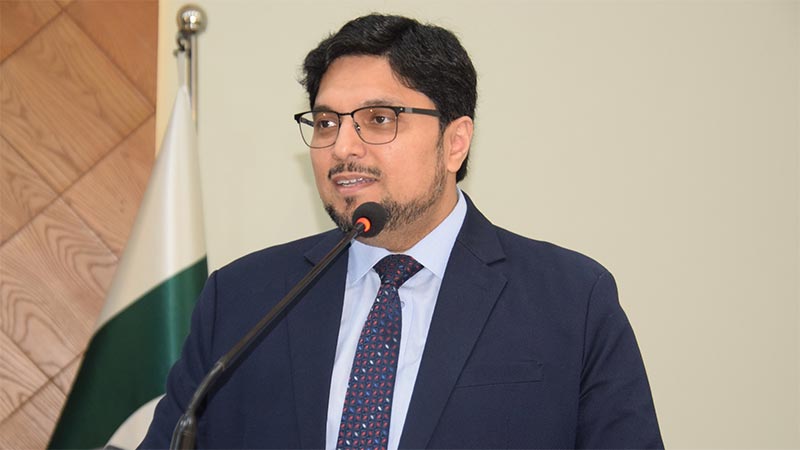
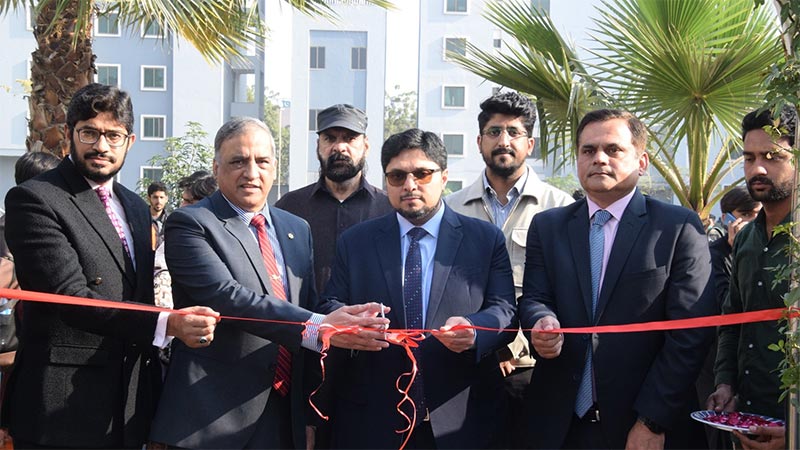
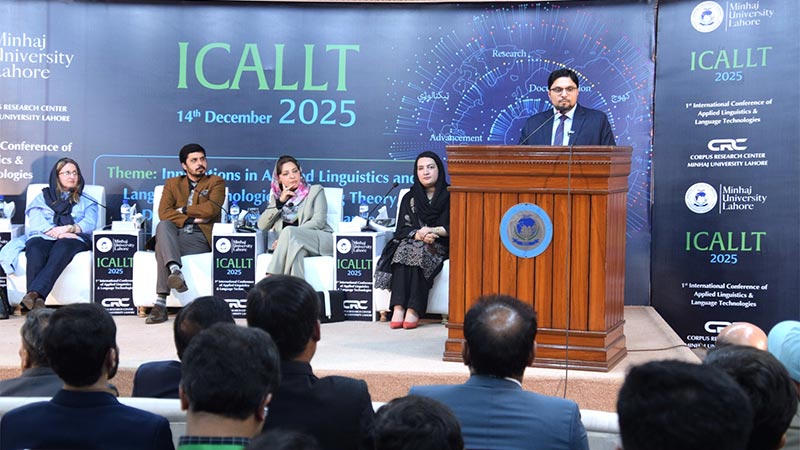

Comments